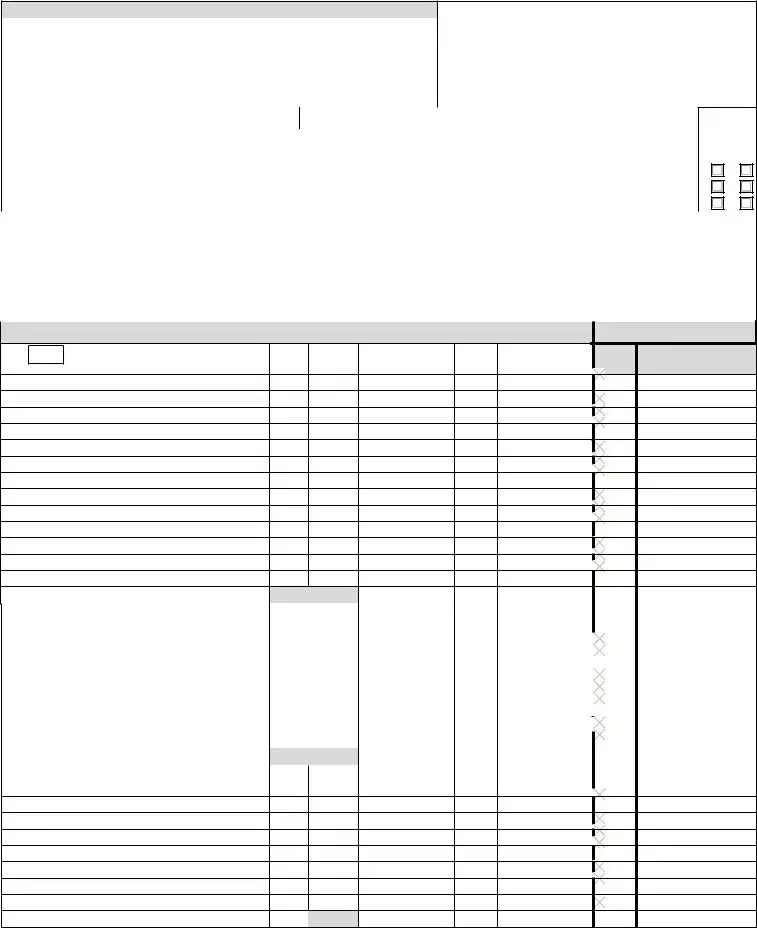LINE INSTRUCTIONS
Within each section, group your assets by year of acquisition. List each item of property separately except for “classes” of personal property. A class is a group of items substantially similar in function, use, and age.
Line 14 - Farm, Grove, and Dairy Equipment
List all types of agricultural equipment you owned on January 1. Describe property by type, manufacturer, model number, and year acquired. Examples: bulldozers, draglines, mowers, balers, tractors, all types of dairy equipment, pumps, irrigation pipe - show feet of main line and sprinklers, hand and power sprayers, heaters, discs, fertilizer distributors.
Line 16 and 16a - Hotel, Motel, Apartment and Rental Units (Household Goods)
List all household goods. Examples: furniture, appliances, and equipment used in rental or other commercial property. Both residents and nonresidents must report if a house, condo, apartment, etc. is rented at any time during the year
Line 17 - Mobile Home Attachments
For each type of mobile home attachment (awnings, carports, patio roofs, trailer covers, screened porches or rooms, cabanas, open porches, utility rooms, etc.), enter the number of items you owned on January 1, the year of purchase, the size (length X width), and the original installed cost.
Line 20 - Leasehold Improvements, Physical Modifications to Leased Property
If you have made any improvements, including modifications and additions, to property that you leased, list the original cost of the improvements. Group them by type and year of installation.
Examples: slat walls, carpeting, paneling, shelving, cabinets. Attach an itemized list or depreciation schedule of the individual improvements.
Line 22 - Owned by you but rented to another
Enter any equipment you own that is on a loan, rental, or lease basis to others.
Line 23 - Supplies
Enter the average cost of supplies that are on hand. Include expensed supplies, such as stationery and janitorial supplies, linens, and silverware, which you may not have recorded separately on your books.
Include items you carry in your inventory account but do not meet the definition of “inventory” subject to exemption.
DR-405, R. 12/11, Page 4
COLUMN INSTRUCTIONS
List all items of furniture, fixtures, all machinery, equipment, supplies, and certain types of equipment attached to mobile homes. For each item, you must report your estimate of the current fair market value and condition of the item (good, average, poor). Enter all expensed items at original installed cost.
Do not use “various” or “same as last year” in any of the columns. These are not adequate responses and may subject you to penalties for failure to file.
Taxpayer's Estimate of Fair Market Value
You must report the taxpayer's estimate of fair market value of the property in the columns labeled "Taxpayer's Estimate of Fair Market Value." The amount reported is your estimate of the current fair market value of the property.
Original Installed Cost
Report 100% of the original total cost of the property in the columns labeled "Original Installed Cost." This cost includes sales tax, transportation, handling, and installation charges, if incurred. Enter only unadjusted figures in "Original Installed Cost" columns.
The original cost must include the total original installed cost of your equipment, before any allowance for depreciation. Include sales tax, freight- in, handling, and installation costs. If you deducted a trade-in from the invoice price, enter the invoice price. Add back investment credits taken for federal income tax if you deducted those from the original cost. Include all fully depreciated items at original cost, whether written off or not.
Assets Physically Removed
If you physically removed assets last year, complete the columns in the first section of page 2. If you sold, traded, or gave property to another business or person, include the name in the last column.
Leased, Loaned, and Rented Equipment
If you borrowed, rented, or leased equipment from others, enter the name and address of the owner or lessor in the second section of page 2. Include a description of the equipment, year you acquired it, year of manufacture (if known), the monthly rent, the amount it would have originally cost had you bought it new, and indicate if you have an option to buy the equipment at the end of the term.






 TOTAL
TOTAL